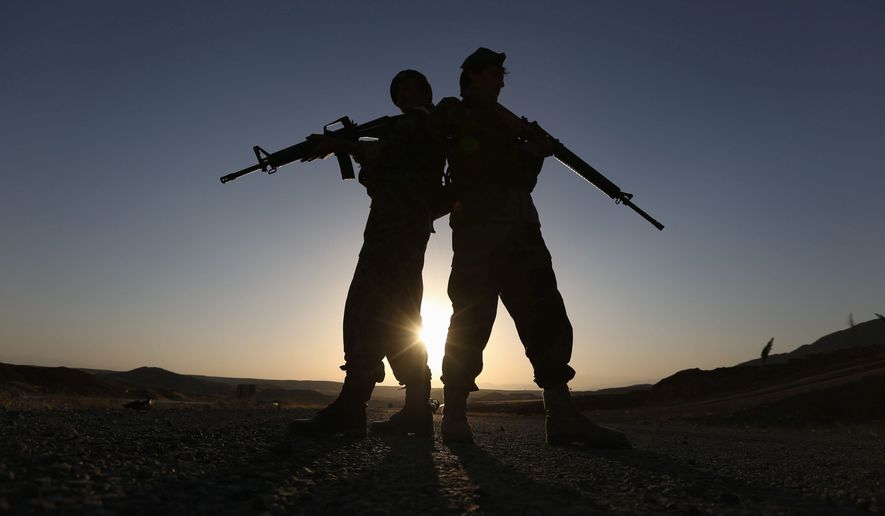OPINION:
Watching the White House press secretary, Josh Ernest, and his deputy, Eric Shultz, going through verbal jujitsu trying to explain why the Obama administration doesn’t consider the Afghanistan Taliban a terrorist organization is tortuous. Shultz started a firestorm when recently suggesting to the press it wasn’t a terror organization but merely an armed insurgency not as dangerous as ISIS. Ernest elaborated by claiming it didn’t have a global reach.
It may come as a surprise to them but the Afghan Taliban’s entire existence has been based on using terrorist tactics to subjugate and intimate local populations and it meets all of the U.S.-established criteria for a State Department designation as a terror group.
The Taliban have shocked the conscience of every decent global citizen by engaging in a reign of terror against noncombatants and enemies since gaining control of Afghanistan’s government in the mid-1990s. While ruling Afghanistan, the Taliban sheltered Osama Bin Laden and his minions, they destroyed the country’s education system in favor of schooling by Muslim clerics teaching little more than Koranic verses, and they banned women from attending school. After being removed from power by American and Afghanistan Northern Alliance forces in 2001, they have gradually grown in strength - largely the result of benefiting from opium poppy drug trade revenues and intimidating and terrorizing local populations. More recently, its terrorist activities in Afghanistan have increased as the U.S. and NATO’s military footprint diminished.
The Immigration and Nationality Act, as amended, requires the secretary of state to provide Congress, by April 30 of each year, a full and complete report on terrorism with regard to those countries and groups meeting criteria, and the penalties, set forth in the legislation. The most recent report for 2013 identifies 59 groups, including the Pakistani Taliban (Tehrik-e Taliban or TTP), as terror organizations but not the Afghan Taliban. And it’s not inconsequential to note that the Afghan Taliban is far more dangerous to U.S. citizens and security interests and local population than almost every group the State Department currently considers a terror group.
To receive an FTO designation under INA, groups must meet the following criteria:
1. Be a foreign organization. The Taliban fit that bill. This Sunni Muslim fundamentalist group operates in Afghanistan and Pakistan and practices the strictest form of Islam. It grew out of an Islamic religious school student movement in the two countries’ sprawling and connected Pashtun regions. The group and its affiliates draw primarily from a tribal network of 40 million Pashtuns residing in those two countries, particularly poverty-stricken and undereducated youth who receive indoctrination in jihad in local mosques and madrasahs.
2. Engage in terrorist activity. The Taliban measure up here, as well. The National Consortium for the Study of Terrorism and Responses to Terrorism, the U.N. Assistance Mission in Afghanistan, and the U.S. Counterterrorism Center have chronicled the casualties and atrocities caused and committed by the Afghan Taliban. The list of Taliban-attributed attacks presented present a horrifying array of kidnappings, beheadings and bombings of innocents in buses, hospitals, public areas and events, private residences and mosques. Moreover, the U.S. has a $10 million bounty on its leader, Afghanistan’s Mullah Mohammed Omar who is believed safely havened in Pakistan’s Taliban-controlled territory.
3. Threaten the security of U.S. nationals and the national security of the United States. Again, the Taliban check the box. Presidents George W. Bush and Barack Obama have judged acts committed by the Taliban and their leaders to be threats to U.S. national security, foreign policy, and citizens. Since American military action commenced in and around Afghanistan, U.S. military casualties total 2,356 killed and 20,037 wounded (most through hostile action by Afghan Taliban jihads).
The Clinton, Bush and Obama administrations have not articulated the reasons for failing to designate the Afghan Taliban as an FTO. The most reasonable assumption is that administration officials were hopeful that non-listing would eventually facilitate rapprochement with “reconcilable” Taliban elements, eventually leading to a peaceful resolution to the Afghanistan War. Each passing day makes that approach seem more like a fantasy.
The White House is in denial if it truly believes the Afghan Taliban isn’t a dangerous terror organization. Congressional overseers should demand, in hearings or otherwise, for the White House and State Department to fully explain why the group isn’t on the State Department terror list. It’s an important question – not only because leaving the Taliban off the State Department’s terror list diminishes the report’s value, undermines White House and State Department credibility, and could further threaten U.S. national security – but because not doing so may further endanger those Americans serving in and around Afghanistan in defense of the United States.
Fred Gedrich is a foreign policy and national security analyst and served in the State and Defense departments.




Please read our comment policy before commenting.